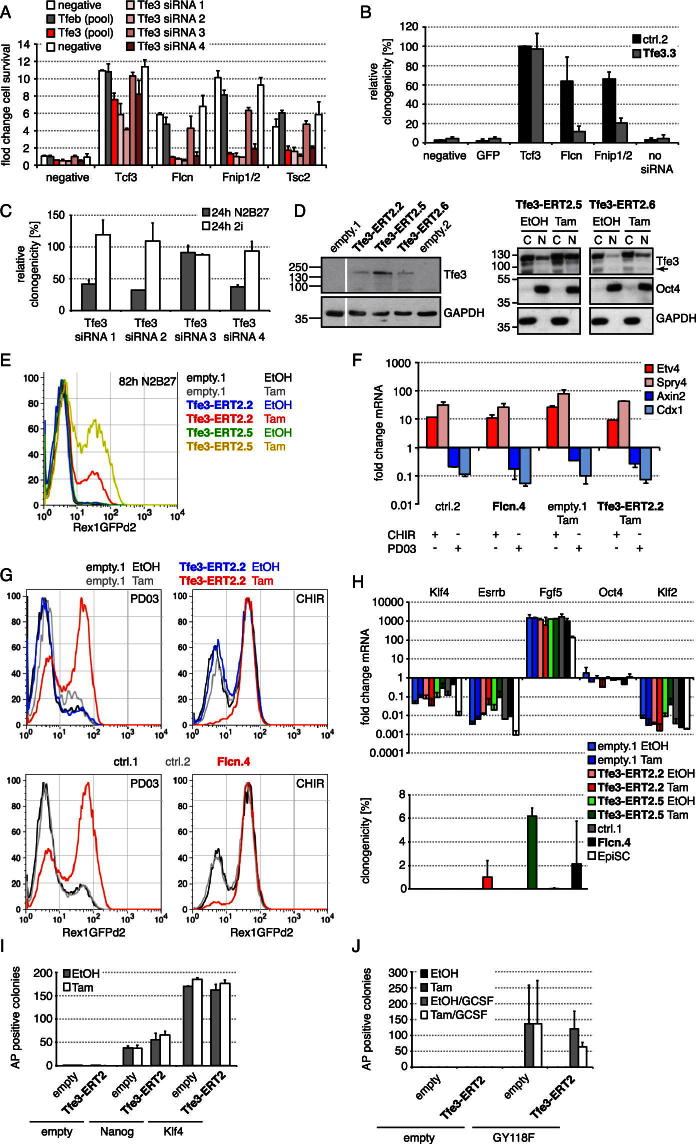Figure S5.
Related to Figure 5
(A) Deconvolution of the Tfe3 siRNA pool. O4GIP ESCs were transfected with indicated siRNA combinations, and after differentiation for 3 days, exit from pluripotency quantified with a cell-viability assay and normalized to negative siRNA transfection. Average and SD are of two technical replicates.
(B) Clonogenicity of differentiated Tfe3 shRNA knockdown cells (Tfe3.3) and controls (ctrl.2) transfected with indicated siRNAs and replated into 2i with Rex1-expression selection. To account for transfection efficiency variability, resulting AP-positive clone numbers were normalized to Tcf3 siRNA in control cells. Average and SD are of two independent experiments.
(C) Deconvolution of the Tfe3 siRNA pool. Rex1GFPd2 cells were transfected with individual siRNAs and exposed for 24 hr to the indicated culture conditions, and ESCs quantified by replating single cells in 2i with Rex1-expression selection. Average clonogenicity and SD are of two technical replicates relative to negative siRNA-treated controls (Figure 5B).
(D) Western blot of Tfe3-ERT2-expressing clones probed with Tfe3 and GAPDH antibodies to control for loading (left panel). Cytoplasmic (C) and nuclear (N) fractions of two Tfe3-ERT2-expressing clones probed with indicated antibodies (right panel). Arrow indicates endogenous Tfe3.
(E) Flow cytometry of Rex1GFPd2 expression in Tfe3-ERT2.2 and 5 clones, and empty.1 vector control differentiated in the presence or absence of 0.1 μM Tam for 82 hr.
(F) Flcn shRNA knockdown (Flcn.4) and Tfe3-ERT2-expressing ESC clones with respective controls were treated for 6 hr in the presence of PD03 or CHIR only and expression of indicated mRNAs determined. Average relative to the respective genotype maintained for 6 hr in 2i and SD are of two independent experiments.
(G) Flow cytometry of Rex1GFPd2 expression in Tfe3-ERT2-expressing (upper panels), Flcn shRNA knockdown cell clones (lower panels) and controls maintained for four passages in PD03 (left panels) or CHIR (right panels).
(H) Tfe3-ERT2-expressing clones (empty.1, Tfe3-ERT2.2 and Tfe3-ERT2.5) were culture for three passages in EpiSC conditions with and without Tam. Similarly, Flcn shRNA knockdown clones (ctrl.1 and Flcn.4) were converted for three passages into EpiSC culture conditions. Fold transcript changes relative to parental cells in 2i and SD are from two technical replicates, and for comparison, expression in O4GIP EpiSCs is shown (upper panel). Exit from the ESC state was quantified by replating single cells in 2i with Rex1-expression selection. Average clonogenicity relative to number of plated cells and SD are of three independent experiments (lower panel).
(I and J) OEC-2 EpiSCs coexpressing an empty vector (empty) and Tfe3-ERT2 with reprogramming factors (empty, Nanog or Klf4) (I) or a chimeric LIF-receptor (empty, GY118F) (J) were treated for 4 days with 2i conditions in the presence or absence of Tam, and including GCSF to activate the chimeric receptor (J). Cells were then switched to 2i with selection for Oct4 expression, and emerging ESC colonies quantified by AP. Averages and SD are of two independent experiments.

